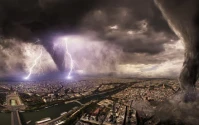The Great Escape: Why Corporations and Governments Always Get Away With It
Alright, let's talk about justice. Or, more accurately, let's talk about the theater of justice, because what just went down in London's High Court with mining giant BHP and the Mariana dam collapse? It felt like a win. A big, fat, £36 billion win for over 600,000 Brazilians whose lives got absolutely pulverized by toxic mud back in 2015. The court said it loud and clear: BHP was liable. UK court finds mining firm liable for Brazil's worst environmental disaster - BBC Their decision to keep jacking up that dam's height, even when it was clearly unsafe, was the "direct and immediate cause" of Brazil’s worst-ever environmental disaster. Nineteen dead, hundreds of homes wiped off the map, a river turned into a sewer of iron ore waste. This ain't no movie disaster, folks; this was real, lurid horror.
But here’s the thing about these "victories" against the Goliaths: they're rarely the knockout punch you think they are. BHP, bless their corporate hearts, immediately announced they'd appeal. Of course they would. They’re already spinning the yarn that 240,000 of those claimants got paid off in Brazil by the Renova Foundation – a foundation they, along with co-owner Vale, conveniently set up. Sounds noble, right? Until you hear the firm representing the victims, Pogust Goodhead, alleging these companies pressured people to settle for peanuts. And then, in a twist that could only happen in this clown show, Pogust Goodhead itself got accused by a Brazilian judge of "misleading" vulnerable folks with "abusive clauses" and "excessive" fees. So, even when you think you’ve got the bad guy cornered, it turns out everyone's got their hand in the cookie jar, leaving the actual victims caught in the middle. It’s a classic shell game, a corporate three-card monte, and honestly...
The Seismic Shuffle and the Floodgates of Forgetfulness
You want another example of how the powerful just… float away? Look no further than Alaska, where NOAA decided that $300,000 was just too much to spend on nine seismic stations crucial for tsunami early warnings. US West Coast at risk from catastrophic disaster as early warning systems go dark in DAYS - Daily Mail Yeah, you heard that right. Three hundred grand. Pocket change for any mid-tier influencer, but apparently a budget-breaker for protecting the entire US West Coast and Hawaii from a massive disaster. These sensors have been there since the late 90s, silently doing their job, detecting over 24,000 earthquakes this year alone. Major quakes—we're talking magnitude 7 and up—can trigger tsunamis. We know this. We've seen it. Hell, a 1946 tsunami killed 150 people in Hawaii before we had these systems.
And what's the public reaction? Some genius online is out there saying, "Oh, older equipment, modern technology, media sensationalism." Give me a break. This ain't about old tech; it's about no tech where it counts. It's about a penny-wise, pound-foolish decision that could lead to a tragedy on the scale of, well, a Cascadia Subduction Zone mega-quake, which scientists say is "almost certain" by 2100. We're talking 100-foot waves, 13,800 estimated deaths. But hey, three hundred thousand dollars! Can't be too careful with that budget, can we? It’s like watching someone dismantle the fire alarms in their own house to save on battery costs. Then again, maybe I'm the crazy one here for thinking basic public safety isn't a negotiable line item.

Meanwhile, in Colorado, Governor Jared Polis is begging President Trump and FEMA for a major disaster declaration. Why? Because Tropical Storm Priscilla and then, just 36 hours later, Tropical Storm Raymond, decided to dump unprecedented amounts of water on Archuleta County in October 2025. This wasn't just a bad storm; these were the 3rd and 4th highest flood events there since 1911. Roads, bridges, water systems—over $13.8 million in damage to public infrastructure, nearly 400 homes evacuated. Polis declared a state emergency, unlocked $6 million in state funds, but that's just a drop in the bucket for disaster recovery. It’s a classic cycle: nature hits hard, often harder than ever before, and then local governments are left scrambling, hoping the feds will ride in like a superhero movie rescue squad. But where's the long-term plan? Where's the foresight to prevent these increasingly common natural disasters from turning into a constant drain on public funds and human lives? We keep patching up the holes instead of rebuilding the dam, and we just assume someone else will pick up the tab.
The Bill Always Comes Due, Just Not for Them
So, what's the common thread here? Corporations get caught, but then they appeal, they spin, they use their own "foundations" as shields, and their lawyers—and sometimes even the victims' lawyers—end up in their own squabbles over the spoils. Governments, meanwhile, make boneheaded decisions, cutting vital services for what amounts to chump change, only to face the inevitable, much larger costs of disaster assistance and disaster relief when the bill comes due. They kick the can down the road, hoping it won't be their watch when the big one hits.
It's a system designed for "the great escape." The powerful always seem to find a trap door, a legal loophole, or a convenient scapegoat. They don't really get away with it because the damage is real, the lives are lost, the homes are gone. But they escape the full, crushing weight of accountability. We, the people, we’re the ones left to clean up the mess, to pay the price, and to remember that the next inevitable disaster, whether corporate-made or nature's fury, is offcourse going to hit us, not them. It ain't right, and it ain't changing anytime soon.










